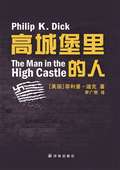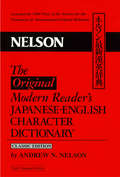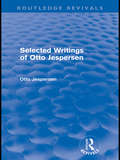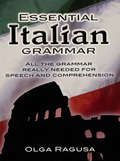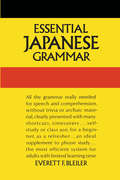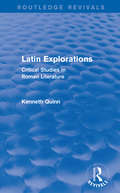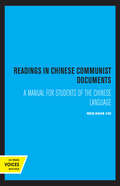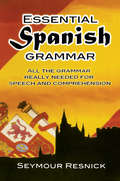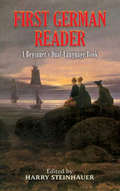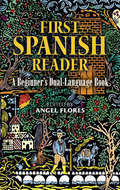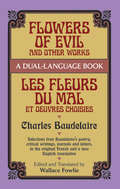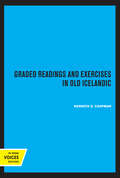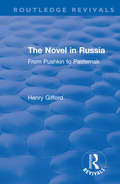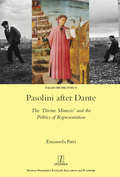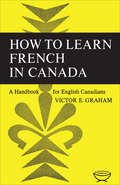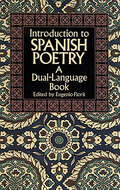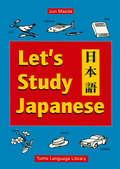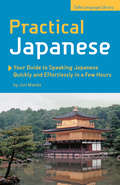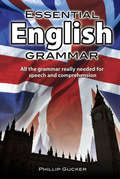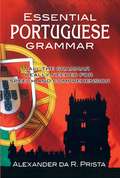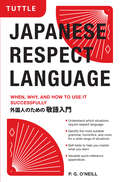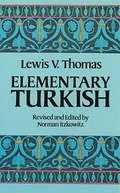- Table View
- List View
The Man in the High Castle (Mandarin Edition)
by Philip K. DickIt's America in 1962. Slavery is legal once again. The few Jews who still survive hide under assumed names. In San Francisco, the I Ching is as common as the Yellow Pages. All because some twenty years earlier the United States lost a war--and is now occupied by Nazi Germany and Japan.小说以 易经 牵引情节 通过对不同阶层,不同身份的人物的穿插描述 讲述了一个反转过来的 历史----同盟国在二战中战败 美国被德国和日本分割霸占 探讨了正义与非正义,文化自卑和身份认同 以及法西斯独裁和种族歧视给人类社会造成的后果 通过对一系列不同人物的塑造 菲利普*迪克讲述了真实和虚幻的生活及历史
The Original Modern Reader's Japanese-English Character Dictionary
by Andrew M. Nelson"The Japanese government may someday recognize-- as it ought to--Tuttle's contribution to creating an intelligent interest in Japan among the English-reading public, and deepening understanding of Japanese overseas."--Hokubei Mainichi (San Francisco)Awarded the 1969 Prize for the Society of the Promotion of International Cultural Relations, this is the most comprehensive Japanese book of its kind. Containing Japanese-English and English-Japanese sections, it is an essential reference tool for serious students studying the Japanese language or for business people and tourists wishing to learn Japanese before they travel.Special features include: Lists over 5,000 carefully selected characters with their 10,000+ current readings and almost 70,000 compounds in current use, al with concise English definitions. Scientifically arranged by a logical extension of the traditional radical system so as to make the finding of a given character almost fool-proof, saving hours of time. Makes provision for quickly finding characters either in their traditional or their modern and often greatly altered forms, thus serving for both prewar and postwar literature. Includes 14 valuable appendices giving (1) instructions for the most efficient use of the book, (2) discussions of the written language in general and particularly of its recent and far-reaching official modifications, and (3) much helpful
Say It in French (Dover Language Guides Say It Series)
by DoverContains over 1,000 useful sentences and phrases for travel or everyday living abroad: food, shopping, medical aid, courtesy, hotels, travel, and other situations. Gives the English phrase, the foreign equivalent, and a transliteration that can be read right off. Also includes many supplementary lists, signs, and aids. All words are indexed.
Selected Writings of Otto Jespersen (Routledge Revivals)
by Otto JespersenThis volume, first published in 1960 to commemorate the one hundredth birthday of Jespersen, collects together as many of his writings as possible in order to allow students of the English language, or indeed of language in general, to read those shorter papers which have hitherto escaped their notice. The layout of the book largely follows the nature of the subjects dealt with: English grammar, phonetics, history of English, language teaching, language in general, international language and miscellaneous papers.
Essential Italian Grammar: Essential Grammar (Dover Language Guides Essential Grammar)
by Olga RagusaIn this very useful manual, Dr. Ragusa has presented all the Italian really needed in everyday life and contemporary situations, without devoting space to the intricacies of literary, archaic, and poetic forms that you are not likely to need.It is remarkable how readily Italian grammar lends itself to this form of essential grammar, for within this book Miss Ragusa has presented her material with such clarity that you will probably remember most of what you have read after a single reading. Among the unusual features of this presentation are an extremely clear statement of the complex pronoun situation, an easily followed analysis of the various verb tenses and moods, and a most useful discussion of the many verb idioms that are so important in Italian.All the major aspects of Italian grammar are presented in logical, developmental order: vocabulary, vocabulary building, word order, turning negative sentences into positive and vice versa, forming questions, nouns, articles, prepositions, adjectives, adverbs, verbs, verbal idioms, and whatever else is necessary to a knowledge of essential Italian. An appendix contains clear definitions of all the grammatical terms used in the book.Essential Italian Grammar is not a simplified grammar, not an abridged grammar, but a selected grammar for adult use, with emphasis upon explanation rather than rote memory, and with inclusion of much phrase material for examples. It can be used as a supplement to a course, as an introduction, or as a refresher for those who have already studied Italian.
Essential Japanese Grammar (Dover Language Guides Essential Grammar)
by E. F. BleilerAlthough not a member of the Indo-European language family, Japanese is not too difficult grammatically for an English speaker. It is astonishingly regular in its formations -- exceptions and irregularities can usually be numbered on one's fingers -- and once the student masters a few conventions of linguistic classifications of experience, he will find that he can express most of his wants.This is the first Japanese grammar written for the adult with a limited objective in studying Japanese: to express oneself orally with reasonable accuracy; to understand simple material addressed to oneself; and to be able to analyze, understand, and enlarge material in a phrase approach.The author has limited this book to modern colloquial Japanese, and does not overburden the student with literary language, rarely used alternate forms, unnecessary abrupt forms, causatives and direct conditionals, and similar forms that might be required for a full knowledge of the written language. On the other hand, this book is not simplified Japanese, nor baby Japanese, nor kitchen Japanese. It is the full idiomatic language, with thorough treatments of the material you really need: the noun, pronoun, adjective, demonstrative words, adverb, verb, negative forms, Chinese forms, courtesy and honorific forms, idiomatic constructions, word order, relationship of ideas, syntax, etc.Emphasis has been placed upon clarity of exposition, so that the English-speaking reader can understand what is really happening in Japanese, even if he has never studied any foreign language before. For this reason, explanation rather than brute memory work is stressed, examples are given for all constructions, and both word-for-word and free translations are given, to acquaint the reader with thought processes. Hints are given on avoiding difficult constructions. Japanese is presented in the Romaji transliteration, which can be read at sight. Characters are not used.
Latin Explorations: Critical Studies in Roman Literature (Routledge Revivals)
by Kenneth QuinnLatin Explorations, first published in 1963, offers a fresh approach to Roman poetry from Catullus to Ovid. Traditionally, the period is divided for specialist studies – Lyric, Epic and Elegy. In each of them, techniques of interpretation prevail, isolated from contemporary ideas about poetry and dominated by barriers between ‘textual’, ‘exegetical’ and ‘aesthetic’ criticism. Kenneth Quinn discerns in Roman poetry of this period the adolescence, maturity and decay of a single coherent tradition whose internal unity surpasses differences of form. His argument attempts to reverse the dissociation of purely academic research from appreciative criticism, whilst also incorporating the work of textual scholars. Each chapter is supported by a detailed analysis of the texts: nearly 700 lines of poetry are discussed and translated. Latin Explorations will be of significant value not only to students of the Classics, but also to the ‘Latinless’ general reader who is interested in Roman literature.
Readings in Chinese Communist Documents: A Manual For Students Of The Chinese Language (classic Reprint)
by Wen-Shun ChiThis title is part of UC Press's Voices Revived program, which commemorates University of California Press’s mission to seek out and cultivate the brightest minds and give them voice, reach, and impact. Drawing on a backlist dating to 1893, Voices Revived makes high-quality, peer-reviewed scholarship accessible once again using print-on-demand technology. This title was originally published in 1963.
Essential Spanish Grammar
by Seymour ResnickThis Spanish grammar has been designed specifically for the adult with limited learning time. It covers the most important points of Spanish grammar in the clearest possible way, concentrating on the expressions that you would be most likely to use. All rules are illustrated with common phrases, and hints are included throughout the book on how to replace difficult constructions with simpler ones.All the major aspects of Spanish grammar are presented in logical order: vocabulary and vocabulary building; word order; how to turn a positive sentence into a negative one; how to form questions; nouns; pronouns; adjectives; adverbs; how to conjugate verbs in the major tenses; how to use auxiliary verbs; prepositions and infinitives; useful expressions; and vocabulary tips. One section is devoted to the definition of all grammatical terms used throughout the book.Not a simplified grammar, this is a selected grammar for adult use. It can be used alone, either as an introductory course or as a refresher, or as a supplement to a record course. Its cognate list of more than 2500 words which are either the same or nearly the same in Spanish and English offers probably the easiest way for you to build your vocabulary, for you will discover that you have already been using very many words that with a slight change in pronunciation are already good Spanish. This is the only place where this useful teaching device is available.
First German Reader: A Beginner's Dual-Language Book
by Harry SteinhauerDesigned expressly for the beginning German language student, here is an outstanding collection of fifty-two short stories, poems, essays, and anecdotes. Each selection has been specially chosen for its power to evoke German life and culture. This dual-language edition features precise English translations on pages that face the original German text. New students will enjoy the pleasure of reading great German literature from the very first page, as the selections have been arranged to accommodate the gradual improvement of language skills. Helpful vocabulary and language exercises are also included. First German Reader features the works of many of Germany's best writers, including Goethe, Hesse, Heine, Schiller, Hölderlin, and other literary virtuosos. The translations of Harry Steinhauer are vivid and true to the originals--and poetic in their own right. Literature lovers, German language students, and other readers will find this volume an accessible exploration of German literature . . . and an invaluable aid to mastering the German language.
First Spanish Reader: A Beginner's Dual-Language Book (Dover Dual Language Spanish)
by Angel FloresEspecially designed for the beginning student, this handy volume helps students learn Spanish by presenting simple, easy-to-read adaptations of classic Spanish stories and other material — with complete faithful English translations on the facing pages.The selections, by significant writers of the past and present (Don Juan Manuel, Luis Taboada, Juan José Milla, Eufronio Viscarra, Ricardo Palma, Lope de Rueda, Enrique Amorim, Juan José Arreola, and other noted writers), derive from the best and most genuine Hispanic tradition, and are revealing of the life and psychology of the Spanish-speaking peoples.The dual-language book will enable those readers with the most limited knowledge of the language to enjoy reading in the original Spanish from the very first day of instruction. Vocabularies and exercises are included as special aids for the student.
Flowers of Evil and Other Works: A Dual-Language Book (Dover Dual Language French Ser.)
by Charles BaudelaireWhen Flowers of Evil was first published in 1857, the book almost immediately became the subject of an obscenity trial, and for several generations afterward its themes of eroticism, lesbianism, revolt and decay earned the author a reputation for depravity and morbidity. It was not until 1949 that the French courts removed the ban originally imposed on Baudelaire's masterpiece.Today, Flowers of Evil is regarded as the poet's greatest work and perhaps the most influential book of French poetry ever written. In assessing Baudelaire's importance in literature, Wallace Fowlie, distinguished scholar, critic and Baudelaire specialist, describes him as "the poet and thinker of our age, of what we like to call modernity."This handsome dual-language edition combines Flowers of Evil with a selection of the poet's other significant compositions, including prose poems from Spleen of Paris, a poignant collection reflecting Baudelaire's pessimism towards the teeming city and his compassion for its less successful inhabitants. Readers will also find critical essays on art, music and literature, including a discussion of Edgar Allan Poe's poetry; and Baudelaire's personal letters to his mother and female acquaintances. Edited and translated by Professor Fowlie, this authoritative edition contains excellent line-by-line English translations with the original French text on the facing pages.Students of French language and literature as well as poetry lovers with some knowledge of French will welcome this volume by one of the greatest European poets of the 19th century.
Graded Readings and Exercises in Old Icelandic
by Kenneth ChapmanThis title is part of UC Press's Voices Revived program, which commemorates University of California Press’s mission to seek out and cultivate the brightest minds and give them voice, reach, and impact. Drawing on a backlist dating to 1893, Voices Revived makes high-quality, peer-reviewed scholarship accessible once again using print-on-demand technology. This title was originally published in 1964.
The Novel in Russia: From Pushkin to Pasternak
by Henry GiffordThe Novel in Russia examines the Russian sensibility as it is revealed in prose fiction, the dominant mode of Russian literature. It explores how, in the work of Pushkin, Lermontov and Gogol, narrative art forsakes poetry for prose, and considers in turn six authors from the great age of prose realism: Goncharov, Turgenev, Leskov, Tolstoy, Saltykov-Shchedrin and Dostoevsky. The book provides an account of Chekhov and Gorky, appraises 'decadent' prose, the earlier Soviet writing, the school of Socialist Realism, and Doctor Zhivago. The theme of the writer's contest with critical pressure and State interference runs throughout.
Pasolini after Dante: The 'Divine Mimesis' and the Politics of Representation (Legenda)
by Emanuela PattiWhat role did Dante play in the work of Pier Paolo Pasolini (1922-1975)? His unfinished and fragmented imitation of the Comedia, La Divina Mimesis, is only one outward sign of what was a sustained dialogue with Dante on representation begun in the early 1950s. During this period, the philologists Gianfranco Contini (1912-1990) and Erich Auerbach (1892-1957) played a crucial role in Pasolini’s re-thinking of ‘represented reality’, suggesting Dante as the best literary, authorial and political model for a generation of postwar Italian writers. This emerged first as ‘Dantean realism’ in Pasolini’s prose and poetry, after Contini’s interpretation of Dante and of his plurilingualism, and then as ‘figural realism’ in his cinema, after Auerbach’s concepts of Dante’s figura and ‘mingling of styles’. Following the evolution of Pasolini’s mimetic ideal from these formative influences through to La Divina Mimesis, Emanuela Patti explores Pasolini’s politics of representation in relation to the ‘national-popular’, the ‘questione della lingua’ and the Italian post-war debates on neorealism, while also providing a new interpretation of some of his major literary and cinematic works.
How to Learn French in Canada: A Handbook for English Canadians
by Victor E GrahamIt is well known that even after several years' exposure to high-school French, most English Canadians remain unable to speak the language. It is equally well known that many French Canadians are bilingual. One of the more obvious explanations for this relative deficiency on the part of the English Canadian is his lack of opportunities to use the French language in day-to-day situations, and, conversely, the French Canadian's need to know the second language, too often perhaps for economic reasons. Professor Graham's book gives useful and practical suggestions on how to go about becoming fluent in French. It offers not a course of instruction, but a listing of practical ways of applying oneself to a study of the language. There is specific, up-to-date information and advice regarding services provided by the governments of Quebec and France, courses offered in various Canadian communities, clubs and societies, correspondence courses, universities and summer schools, and language laboratories. A feature which will be especially helpful for those in remote areas is the listing of publications (books, newspapers, and periodicals), music and songs, records, films, and radio and television programmes which provide instruction in French. The reader will quickly see that the available means are much more varied than he realizes, and it is in providing this concise, convenient enumeration of them that Professor Graham performs a great service. Any adult who is reasonably proficient in French, but wishes to improve, will find this a practical and useful guide to ways of making a personal contribution to bilingualism in Canada. This study has been prepared under the sponsorship of the Canadian Association for Adult Education.
Introduction to Spanish Poetry: A Dual-Language Book (Dover Dual Language Spanish)
by Eugenio FloritFrom the 12th-century Cantar de Mío Cid to the 20th-century poetry of García Lorca, Salinas, and Alberti, this book contains 37 poems by Spain's greatest poets. Selected by Professor Eugenio Florit, the poems are presented in the full original Spanish text, with expert literal English translations on the facing pages. Enjoy the poetic inspiration, imagery, insight, and wisdom of such masters as Lope de Vega, Miguel de Unamuno, Federico García Lorca, Margués de Santillana, Jorge Manrique, Garcilaso de la Vega, Fray Luis de León, San Juan de la Cruz, Francisco de Quevedo y Villegas, Gustavo Adolfo Bécquer, Antonio Machado, Rafael Alberti, Pedro Salinas, and many more. In addition to the poetic texts, Professor Florit has also provided a wealth of biographical and critical commentary, outlining the significance of the poets and their works in the long tradition of Spanish literature. Portraits of the poets are included where available.
Lets Study Japanese
by Jun Maeda"In this jet age, one can reach any part of the world within a day or two. It is wise to have some knowledge of the language of the country one visits to make the trip enjoyable and worthwhile. " -THE AUTHORJun Maeda has purposely written Let's Study Japanese for the tourist visiting Japan, although the book will undoubtedly prove its worth to anyone wanting to acquire a working knowledge of spoken Japanese in short order. With approximately 350 essential words and 130 pages of practical conversational usage, this handy book provides the basics needed to converse in simple Japanese. Intended for beginners, the book concentrates only on key grammar and pronounciation points. Most of the 26 lessons include exercises that reinforce vocabulary items and grammatical structures. Phrases and sentences are recycled for long-term learning. Over 200 simple illustrations allow even beginners to express themselves. in short, Let's Study Japanese is an introduction to basic Japanese that is concise, simple, and useful from the very first page.
Practical Japanese
by Jun MaedaThis is a concise and effective Japanese phrase book and study guide with color picture and accompanying exercises for each section.This book has several exercises for each lesson. And, to get acquainted with Japanese culture, the student may enjoy the photos which the author has provided as a visual aid. Complicated grammatical explanations are omitted, since detailed explanations sometimes discourage people from actually speaking. Only the essential points in pronunciation and grammar are given, and the Japanese phrases and sentences are repeated presented in each lesson, so that the student can easily learn the phrases and practice using them without hesitancy or discouragement. Key features of Practical Japanese are:Over 350 essential Japanese words and 96 pages of practical conversational usage25 carefully structured lessons to reinforce Japanese vocabulary and Japanese grammarAccompanying practice exercises for every lessonAll words and phrases are shown in written Japanese-Kanji and Kana (Hiragana and Katakana), Romanized Japanese (Romanji), and EnglishOver 200 simple illustrationsA concise pronunciation guideBusinesspeople and tourists as well as the student or prospective foreign resident in Japan, young or old will find this Japanese phrasebook a helpful and enjoyable tool in speaking Japanese for the first time.
Practical Japanese
by Jun MaedaThis is a concise and effective Japanese phrase book and study guide with color picture and accompanying exercises for each section.This book has several exercises for each lesson. And, to get acquainted with Japanese culture, the student may enjoy the photos which the author has provided as a visual aid. Complicated grammatical explanations are omitted, since detailed explanations sometimes discourage people from actually speaking. Only the essential points in pronunciation and grammar are given, and the Japanese phrases and sentences are repeated presented in each lesson, so that the student can easily learn the phrases and practice using them without hesitancy or discouragement. Key features of Practical Japanese are:Over 350 essential Japanese words and 96 pages of practical conversational usage25 carefully structured lessons to reinforce Japanese vocabulary and Japanese grammarAccompanying practice exercises for every lessonAll words and phrases are shown in written Japanese-Kanji and Kana (Hiragana and Katakana), Romanized Japanese (Romanji), and EnglishOver 200 simple illustrationsA concise pronunciation guideBusinesspeople and tourists as well as the student or prospective foreign resident in Japan, young or old will find this Japanese phrasebook a helpful and enjoyable tool in speaking Japanese for the first time.
Essential English Grammar
by Philip GuckerThis English grammar has been specially designed for readers with limited learning time, who wish to gain command of all the important points of grammar needed for everyday speech and comprehension, yet who do not wish to be unnecessarily burdened with archaic, highly literary, or seldom used forms. Summarizing all the major constructions, principles, and basic terminology, this book will provide readers with a firm foundation in essential English grammar.The text proceeds in easy, natural steps, beginning with simple sentence structure and advancing logically to more difficult constructions. More than 600 practice exercises and solutions make this an excellent home-study text. Organized with clarity and emphasizing explanation rather than rote memorization, this selective grammar can be used effectively as a course supplement, as an introduction for beginners, or as a reference for students and teachers.
Essential Portuguese Grammar
by Alexander Da PristaThis is the first Portuguese grammar designed specifically for adults with limited learning time, who have as their objective simple, everyday communication. The author covers the most important points of Portuguese grammar in the clearest possible way, concentrating upon the expressions that you would be most likely to use. All grammatical rules are illustrated with phrases and sentences that you can incorporate directly into your working vocabulary, and hints are generously sprinkled throughout, showing you how to replace difficult constructions with simpler ones.Constantly drawing comparisons with English construction, it presents in logical order all the major aspects of Portuguese grammar: word order, forming questions, nouns and articles, adjectives and adverbs, possessives, demonstrative adjectives and pronouns, how to form negatives, personal pronouns, conjunctions and prepositions, how to conjugate verbs in the major tenses, prepositions and infinitives, and so on.This grammar does not assume prior knowledge of either Portuguese grammar or of grammatical terms: one section is devoted to the definition of all grammatical terms used in the book.This is not a simplified study, but rather a selected grammar for adult use that points out many time-saving short cuts. It can be used alone either as a beginner or as a refresher course in Portuguese grammar or it can be an ideal supplement to a phrase book or record course for home study or class use. Contains four appendices covering regular conjugations, orthographic-changing verbs, and irregular verbs. Glossary of grammatical terms. Index.
Japanese Respect Language: When, Why, and How to use it Successfully
by P. G. O'NeillRespect language—the special style of polite spoken or written Japanese—is involved almost every exchange of Japanese between one person and another, including the simplest phrases of greeting.<P><P> An understanding of its forms is therefore essential to any serious student of the Japanese language. This programmed course is carefully designed to teach the basic and correct forms which the learner should master for his or her own use, by first looking at the various typical situations to see when respect should and should not be shown in Japanese, and then going on to see how respect is expressed in special forms of speech. In this way the learner is shown how to identify the type of respect for used, the person to whom respect is being shown, and the equivalent form in colloquial language. The insights into both Japanese culture and language will help any student or businessperson traveling to Japan or speaking Japanese on a regular basis.
Elementary Turkish (Dover Language Guides)
by Lewis ThomasTurkish is the primary language of some thirty million people. Anyone concerned with current social, political, and cultural developments in Turkey knows that a practical understanding of the basic patterns of modern Turkish is an invaluable skill that until now has been difficult to attain without extensive training.This superb grammar and exercise text, used successfully for years in Princeton University, enables English-speaking students — in and out of the classroom — to gain a quick and thorough understanding of modern Turkish. In a carefully arranged sequence of 23 lessons, Lewis V. Thomas, late Professor of Oriental Studies at Princeton, presents thorough coverage that allows the student to begin to use the basic patterns of modern Turkish without time-consuming and expensive private instruction.The method of instruction was devised after an extensive analysis of results in Princeton classrooms, and relies on exercises at the end of each lesson to test the student's grasp of the material. Beginning with the alphabet and numbers, Professor Thomas offers clear, concise coverage of articles, adjectives and nouns, common infinitives, personal pronouns, and elementary verbs. As the student's comprehension of basic elements develops, further lessons deal with more complicated subjects such as the possessive construction, past general verbs, postpositions, the partitive, progressive verb forms, and abbreviating verb forms. A complete Turkish-English glossary translates new vocabulary occurring in the exercises.Norman Itzkowitz, Professor of Near Eastern Studies at Princeton University, has skillfully made the necessary revisions and additions to complete Professor Thomas' work. For anyone who needs to communicate in this important and influential language, Professor Thomas' proven course, now in an inexpensive paperback edition, is the most effective method available.
Williams Hebrew Syntax (3rd Edition)
by John C. BeckmanAlthough the morphology and lexicon of Hebrew are reasonably well understood, its syntax has long been a neglected area of study. Syntax, the relationship of words to one another, forms, together with morphology, the material of grammar. Its relative importance varies according to the language considered. This is particularly true of word order, for when an inflected language loses its case endings, word order assumes many of the functions of the former cases. <P><P> This outline by Professor Williams re-emphasizes the significance of word order in Hebrew. Developed over fifteen years in a formal course on Hebrew syntax at the University of Toronto, it treats the syntax of the noun, the verb, particles and clauses, with a selection of illustrative examples. Its contents are based on classical Hebrew prose, but some account is also taken of the deviations in later prose and poetry. In this new edition English translations have been provided for all Hebrew phrases and sentences, and the bibliography has been expanded.<P> Advisory: Bookshare has learned that this book offers only partial accessibility. We have kept it in the collection because it is useful for some of our members. To explore further access options with us, please contact us through the Book Quality link on the right sidebar. Benetech is actively working on projects to improve accessibility issues such as these.
